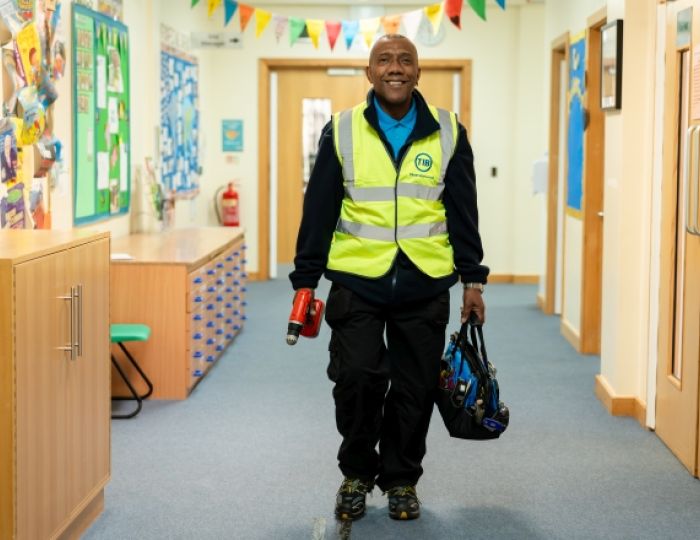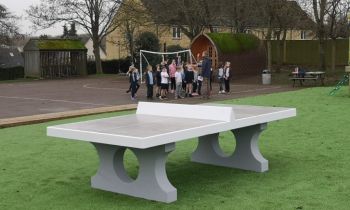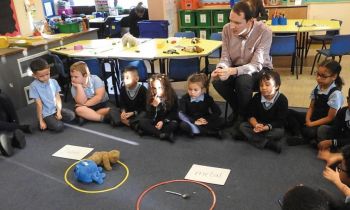It’s a joy to witness how a simple, low cost reading intervention can have a profound impact within a school.
In our experience, the paired reading intervention has been extremely effective for children with barriers to learning in reading, particularly those receiving Pupil Premium funding. Statistics show that the literacy gap is shrinking, but at a very slow pace. While there’s no single solution to narrowing this gap, school-based literacy interventions such as paired reading can really help.
How does it work?
The tutor and child both read out loud together. The tutor can be fractionally ahead, or read alongside the child in unison. When the child feels confident enough to read independently they give a signal, such as a knock on the table. The tutor will then only join in again if and when the child misreads a word – the tutor states the correct word via direct instruction, the child repeats it and they then carry on reading again together.
One might assume that ‘the tutor’ in this instance would be an adult – a teacher, LSA or parent – but what’s interesting is that the intervention can work as a peer support strategy, providing opportunities for cohesive learning throughout the school. More advanced readers can fill the role of tutors, with less advanced readers being the tutees. There’s also the opportunity to encourage discussion between tutors and tutees about the texts they’re using before, during and after paired reading sessions to help promote reading comprehension, and more importantly, build a positive tutor-tutee relationship.
Children make progress when they’re happy, confident, connected to their learning environment and have some control over their learning, which is exactly what this intervention provides. Its psychological underpinnings draw on selfdetermination theory, which posits that the needs of competency, relatedness and autonomy must all be met simultaneously in order to increase intrinsic motivation – the most effective type of motivation for long-term engagement.
Low cost, high impact
In May 2018 we conducted a six-week paired reading intervention at a primary school in North Lincolnshire, St Peter’s CE Primary School. Pupils receiving paired reading increased their reading age by 3.7 months and spelling score by 3.12 points, compared to 1.2 months and -0.34 points for the control group. Pupils’ confidence towards learning increased by 6.59 points in the intervention group, compared to 1.08 points in the control group. (see ‘Paired reading in practice’).
We revisited the school in May this year, to find out how paired reading was continuing to have an impact on the school’s learners and the school as a whole. We saw significant progress in reading, spelling and confidence scores across all participants. Paired reading had originally been implemented for all KS2 children in receipt of Pupil Premium funding, but following the success of the project the intervention had since been rolled out across all of KS2, for children not making expected progress.
Jo Winney, SENCo at Barton St Peter’s CE Primary School, told us, “Part of my remit is to analyse the effectiveness and cost-effectiveness of interventions across the school. This is done by breaking down each intervention into cost per child based upon a number of factors, including length, frequency of intervention, wages of staff delivering and the number of children in a group. Paired reading has been, without question, the most effective intervention for improving reading across the school.”
When it came to reporting these successes to school improvement partners and governors, Barton St Peter’s preferred method of assessment was using termly PiXL tests to measure skills in retrieval, inference and predictions, as well as the language choices, themes and conventions of written texts. Where paired reading was used at least three times a week for a duration of 10 minutes with a trusted adult, the school saw a rise in average pupil reading progress of seven PiXL test points, compared to just three points for those children who didn’t receive the intervention. The cost of the intervention worked out at around £1.80 per session.
According to the school’s headteacher, Adeline Brack, “Following the success of the paired reading pilot project, it has become an integral part of support strategies at our school. The accelerated progress made by those children who participate in paired reading isn’t currently matched by any other intervention, and it’s the most effective intervention we have in terms of boosting confidence and raising attainment.”
A child’s needs
Paired reading sessions are short, typically lasting 10 to 15 minutes, and can be conducted on a one-to-one basis or in small groups – ideally on a daily basis. Given that it works well with standard children’s books, schools can actively promote the intervention among parents and encourage its use at home.
By focusing on hearing and reading words at the whole word level, it’s ideal for children who struggle with decoding and experience phonological difficulties. The approach of reassuring, explaining and maintaining pace underpins the skills of resilience and confidence a child will need when faced with similar challenges in future. What’s important is that it promotes self-efficacy, which fosters positive attitudes towards reading. It becomes fun and enjoyable, giving both tutor and tutee a feeling of accomplishment, and contributes towards getting children to read for pleasure.
The results of our randomised control trial at Barton St Peters CE Primary School were clear. Following the pupils’ use of the paired reading intervention, assessments showed that their word reading, spelling and reading confidence significantly improved, highlighting the value it can have as a primary education strategy for narrowing the literacy gap.
Paired reading is a low cost, simple intervention that can be implemented across a school without the need for specialist resources. An inability to read well can affect children’s academic attainment in the short term, and broader emotional wellbeing in the long term, potentially over the course of their lives. It can be addressed by an intervention that’s been proven to transform reluctant readers into confident, brave and happier ones.
Dr David Lamb is an educational psychologist and director at Applied Psychologies










